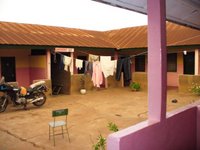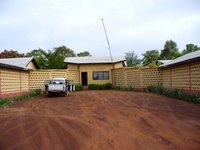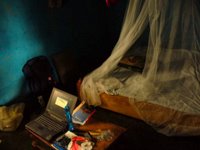The Impact
I am sitting in the passenger seat of the Nissan Patrol, the NGOSUV. The driver and I are fetching lunch for everyone at the office. Each day, everyone pools their money and sends a vehicle into town to pick up whatever they request. As a result of having picked up food countless times, the driver always knows the best place in town for any specific food item. As we twist and turn our way through the narrow streets of bustling Tamale, I try to remember the steps we take to arrive at each chop bar, specializing in anything from kenkey, watche, banku, rice, beans, fried plantains or yams. Each item has one specific location that OIC orders from. The best chop bars can be easily identified by the long line-ups of impatient and hungry Ghanaians, as well as the rows of wooden benches where satisfied individuals quickly heave the steaming hot items into their mouth.
As we travel down the main road towards town, I stare out the window at the chaotic scene around me. Most days, I walk down these streets without a second thought. If a gentlemen passes me on a bike with two-by-fours on his head, I gently tuck my head down. If a motorbike weaves its way towards me on the sidewalk, I gracefully stride to the side. This is a big difference from when I first arrived in Tamale, and would dive out of the way of any obtuse object on the sidewalk, be it sheep, cow, pile of sand, or motorbike. These streets are very different from the view of the SUV, and I realize that when comparing them to the tranquility of Canada's roads, just how hectic they can be. Yet in all my time in Tamale, I have witnessed only one bicycle accident, in the pitch black atmosphere of 7pm, when travelling into town to fetch dinner.
We continue down the road and I glance out my window and who do I see? I see Gwen, a newly arrived EWB LTOV from UBC, buying a sachet of drinking water by the side of the road. We continue further along and I glance out the other side to see Sabrina, a Guelph JF, buying food from a chop bar. I look around me and realize that everywhere we go in Tamale, we bump into each other. I stayed at the Maacos Hotel one weekend, and returned from the communal toilet to discover Louis Dorval sucking back a sachet water in front of his room. He was staying next door. I walk down to my favourite yam place, only to discover Robin, Louis, and Russ sitting back having a meeting enjoying some yams.
I cannot help but wonder what impact we have on this community in such numbers. One late Friday evening, after taking a lorry from Damongo into Tamale, a man stopped his bike and approached me on the street; a normal occurrence when you spot a westerner on the streets of Tamale. He immediately asked if I was Canadian. I was at first a little shocked but I assumed that I had just met him before. I answered: "Yes, I am a Canadian... how did you know?"
"Canadians wear the white band" he said, pointing to the Make Poverty History wristband that adorns my left wrist. I then pointed out that not all Canadians wear the white band, but only a small percentage, and how my presence in Ghana would hopefully make more Canadians wear it. "How?" he asked. I hadn't quite figured that part out yet.
He then began to enquire about his Canadian friends Jon (Saskatchewan JF) and Chloe (Victoria JF). I mentioned that they were both good friends, and he informed me that they had travelled to Mole National Park for the weekend.
A little further, someone called out to me on the street, asking me to say hello to Sarah (Western JF) and Sabrina.
Can negative impact be possible? Is EWB fostering the stereotype that all Canadians know each other? I pondered what the implications would be by replying to people that yes, I am good friends with Troy from Vancouver, BC, or Ian from Newfoundland. Whatever they are, they are going to get stronger as the summer winds down, having almost thirty EWB volunteers and staff in various capacities spread across the Northern Region of Ghana.
So the next time you're in Ghana and someone asks you how Kyle, from Canada is doing. You can let them know that I am just fine.
As we travel down the main road towards town, I stare out the window at the chaotic scene around me. Most days, I walk down these streets without a second thought. If a gentlemen passes me on a bike with two-by-fours on his head, I gently tuck my head down. If a motorbike weaves its way towards me on the sidewalk, I gracefully stride to the side. This is a big difference from when I first arrived in Tamale, and would dive out of the way of any obtuse object on the sidewalk, be it sheep, cow, pile of sand, or motorbike. These streets are very different from the view of the SUV, and I realize that when comparing them to the tranquility of Canada's roads, just how hectic they can be. Yet in all my time in Tamale, I have witnessed only one bicycle accident, in the pitch black atmosphere of 7pm, when travelling into town to fetch dinner.
We continue down the road and I glance out my window and who do I see? I see Gwen, a newly arrived EWB LTOV from UBC, buying a sachet of drinking water by the side of the road. We continue further along and I glance out the other side to see Sabrina, a Guelph JF, buying food from a chop bar. I look around me and realize that everywhere we go in Tamale, we bump into each other. I stayed at the Maacos Hotel one weekend, and returned from the communal toilet to discover Louis Dorval sucking back a sachet water in front of his room. He was staying next door. I walk down to my favourite yam place, only to discover Robin, Louis, and Russ sitting back having a meeting enjoying some yams.
I cannot help but wonder what impact we have on this community in such numbers. One late Friday evening, after taking a lorry from Damongo into Tamale, a man stopped his bike and approached me on the street; a normal occurrence when you spot a westerner on the streets of Tamale. He immediately asked if I was Canadian. I was at first a little shocked but I assumed that I had just met him before. I answered: "Yes, I am a Canadian... how did you know?"
"Canadians wear the white band" he said, pointing to the Make Poverty History wristband that adorns my left wrist. I then pointed out that not all Canadians wear the white band, but only a small percentage, and how my presence in Ghana would hopefully make more Canadians wear it. "How?" he asked. I hadn't quite figured that part out yet.
He then began to enquire about his Canadian friends Jon (Saskatchewan JF) and Chloe (Victoria JF). I mentioned that they were both good friends, and he informed me that they had travelled to Mole National Park for the weekend.
A little further, someone called out to me on the street, asking me to say hello to Sarah (Western JF) and Sabrina.
Can negative impact be possible? Is EWB fostering the stereotype that all Canadians know each other? I pondered what the implications would be by replying to people that yes, I am good friends with Troy from Vancouver, BC, or Ian from Newfoundland. Whatever they are, they are going to get stronger as the summer winds down, having almost thirty EWB volunteers and staff in various capacities spread across the Northern Region of Ghana.
So the next time you're in Ghana and someone asks you how Kyle, from Canada is doing. You can let them know that I am just fine.







